Hibiscus flower enthusiasts are often drawn to its vibrant petals, tropical energy, and unmistakable charm. This beloved bloom isn’t just a showstopper in gardens—it’s also rich in cultural significance, health benefits, and botanical variety. Whether you’re designing a backyard oasis, exploring edible herbs, or simply admiring floral beauty, knowing the different types of hibiscus flowers can help you choose the perfect plant for your space and needs.
In this guide, we’ll look at seven stunning hibiscus flower varieties—from garden classics to rare gems—and what makes each one unique.
Table of Contents
1. Hibiscus rosa-sinensis (Chinese Hibiscus)
The Hibiscus rosa-sinensis, commonly known as the Chinese hibiscus or tropical hibiscus, is perhaps the most iconic hibiscus flower seen in home gardens and tropical landscapes. Native to East Asia, this vibrant bloomer is celebrated for its striking size and color range, making it a favorite among gardeners and florists alike.
Key Features:
- Large, colorful blooms: Flowers measure between 10 to 15 cm and come in shades of red, yellow, orange, pink, and multicolor blends.
- Glossy evergreen foliage: Its lush green leaves contrast beautifully with the vivid flowers.
- Year-round flowering: In warm climates, it blooms continuously, thriving in temperatures above 20°C.
- Pollinator-friendly: Attracts butterflies and hummingbirds, adding more life to your garden.
This hibiscus flower thrives in sunny spots and well-drained soil, making it perfect for tropical gardens or sunny patios. With the right care, it can flower for months, offering a consistent splash of color and elegance.
2. Hibiscus syriacus (Rose of Sharon)
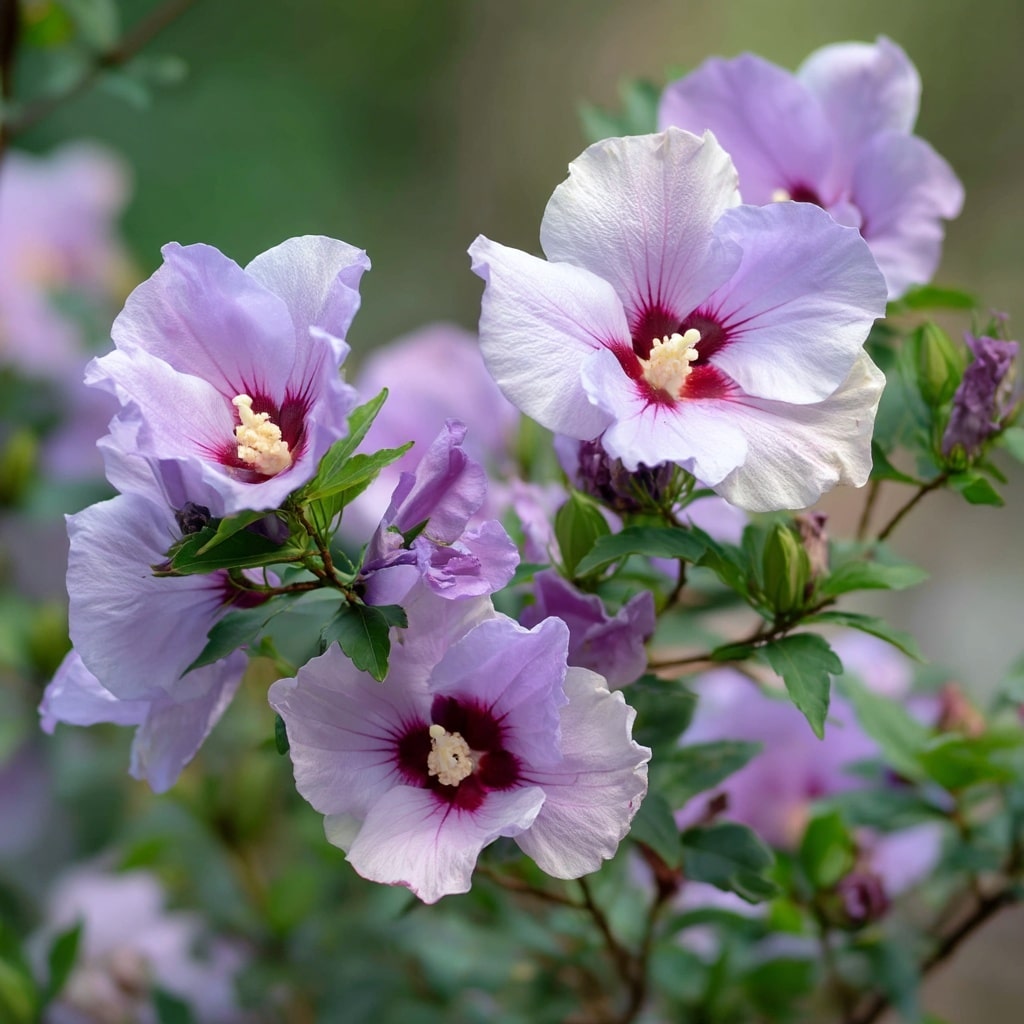
The Hibiscus syriacus, more commonly known as the Rose of Sharon, is a hardy, deciduous shrub that brings hibiscus flower beauty to temperate gardens. Unlike its tropical cousins, this variety tolerates cooler climates, making it a reliable bloomer in regions with distinct seasons.
Key Features:
- Smaller yet abundant flowers: Each bloom measures about 5 to 10 cm and appears in colors like lavender, white, blue, and pink.
- Striking contrast: Most varieties feature a darker-colored throat that gives depth and dimension to the flower.
- Long blooming season: Flowers from late summer into fall, often when other plants have faded.
- Compact and versatile: Reaches heights of 2–3 meters, ideal for hedging, borders, or standalone ornamentals.
Because it’s low-maintenance and frost-tolerant, this hibiscus flower is especially popular with gardeners seeking resilient beauty. It also attracts bees and butterflies, making it a pollinator-friendly choice for any outdoor space.
3. Hibiscus moscheutos (Hardy Hibiscus)
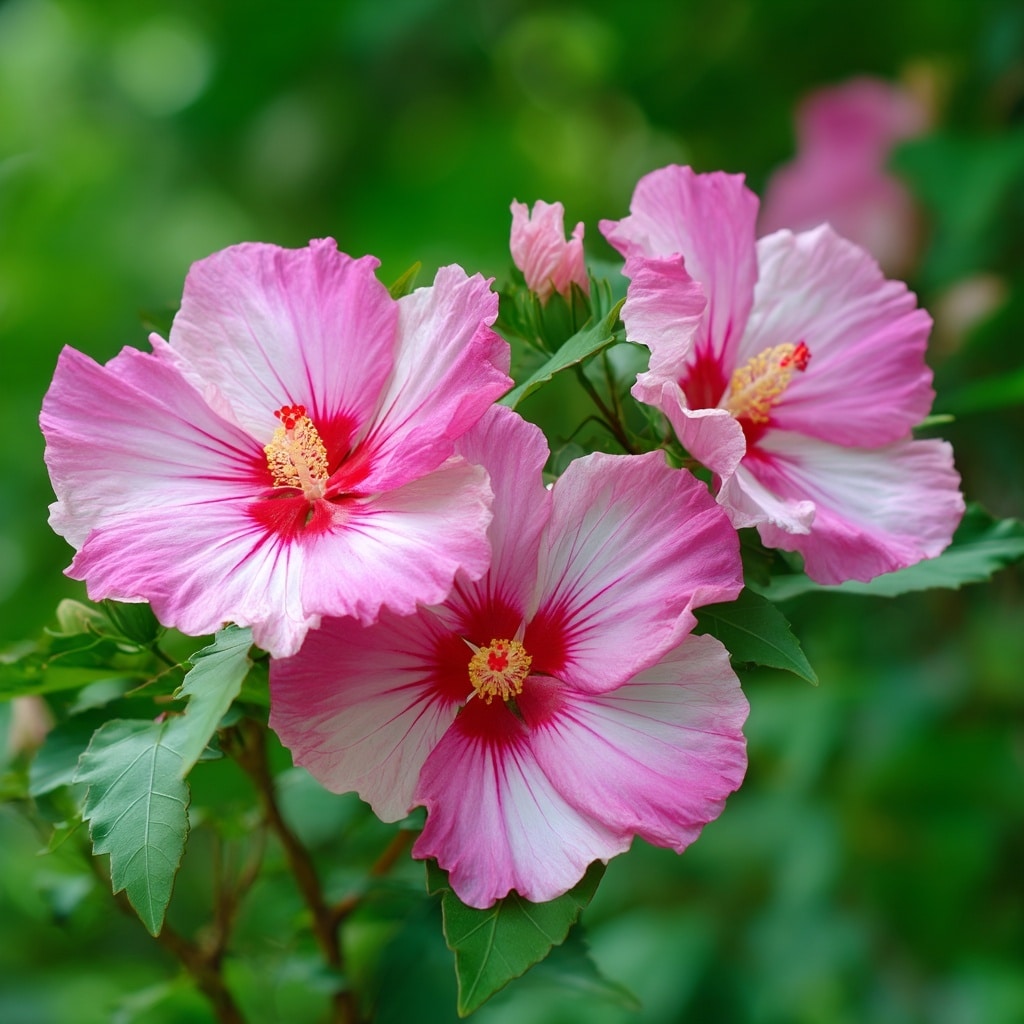
Known for its enormous, show-stopping flowers, the Hibiscus moscheutos—or Hardy Hibiscus—is a perennial favorite among gardeners in cooler regions. Despite its delicate look, this hibiscus flower is incredibly tough, tolerating frosty winters and bouncing back each spring with lush growth and massive blooms.
Key Features:
- Huge flowers: Each bloom can reach an astonishing 25–30 cm across, making it one of the largest hibiscus flower varieties.
- Bold color palette: Common hues include bright white, deep pink, red, and two-toned varieties with contrasting centers.
- Flattened, saucer-shaped petals: These wide blooms create a dramatic focal point in any garden bed or border.
- Cold-hardy nature: Thrives in USDA zones 4–9 and returns year after year with proper care.
This hibiscus flower loves full sun and moist, rich soil. It’s particularly well-suited for cottage gardens or near water features, where its size and shape can be fully appreciated.
4. Hibiscus mutabilis (Confederate Rose)

The Hibiscus mutabilis, often referred to as the Confederate Rose, is a unique hibiscus flower that mesmerizes with its ability to change color throughout the day. Native to China and admired in southern gardens, this large shrub or small tree adds a dynamic touch to landscapes.
Key Features:
- Color-changing blooms: Flowers typically start as white or pale pink in the morning and deepen to rich pink or red by late afternoon.
- Full, fluffy petals: Blooms are often semi-double or fully double, giving them a lush, almost peony-like appearance.
- Large size: Individual flowers reach 10–15 cm in diameter.
- Tall growth: Can grow up to 4–5 meters tall, especially in warmer climates with plenty of sun.
This hibiscus flower variety offers visual drama and seasonal charm from late summer to early autumn. Its changing hues add personality to garden beds and are often a conversation starter among visitors.
5. Hibiscus sabdariffa (Roselle)
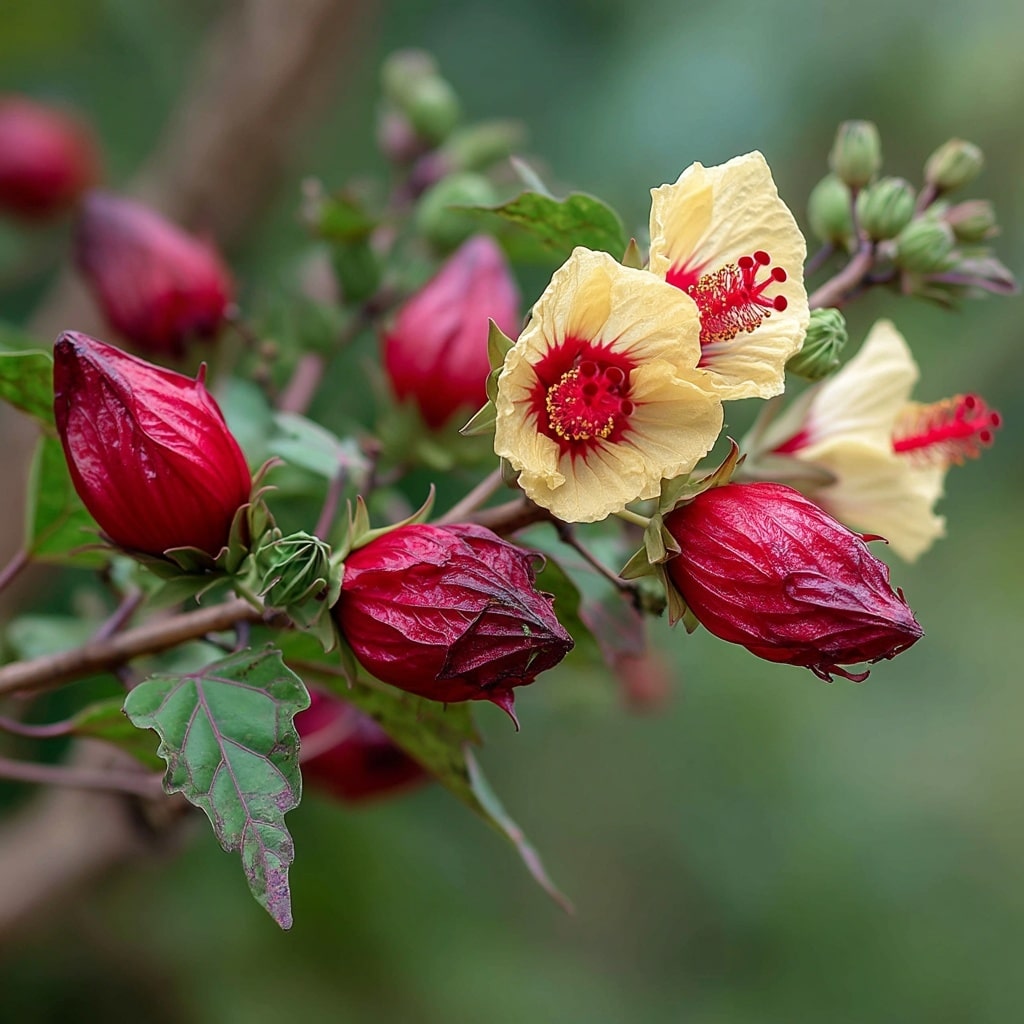
The Hibiscus sabdariffa, more commonly known as Roselle or Red Sorrel, is a powerhouse hibiscus flower prized not only for its appearance but also for its many culinary and medicinal uses. Native to Africa and widely cultivated across tropical regions, this variety is most famous for its role in making hibiscus tea.
Key Features:
- Distinctive calyces: After the flowers fall, Roselle produces fleshy, deep red calyces used in teas, syrups, jams, and even sauces.
- Edible flowers: Pale yellow to light pink with a dark red center, the blooms measure around 8–10 cm in diameter.
- Annual shrub: Grows 1.5 to 2.5 meters tall in a single season, with fast and bushy growth.
- Health benefits: The hibiscus flower calyces are rich in antioxidants and are known for supporting blood pressure and digestion.
Because of its edible parts and fast-growing nature, Roselle is a favorite for herbal gardens and anyone interested in growing functional plants that serve both ornamental and practical purposes.
6. Hibiscus schizopetalus (Japanese Lantern)
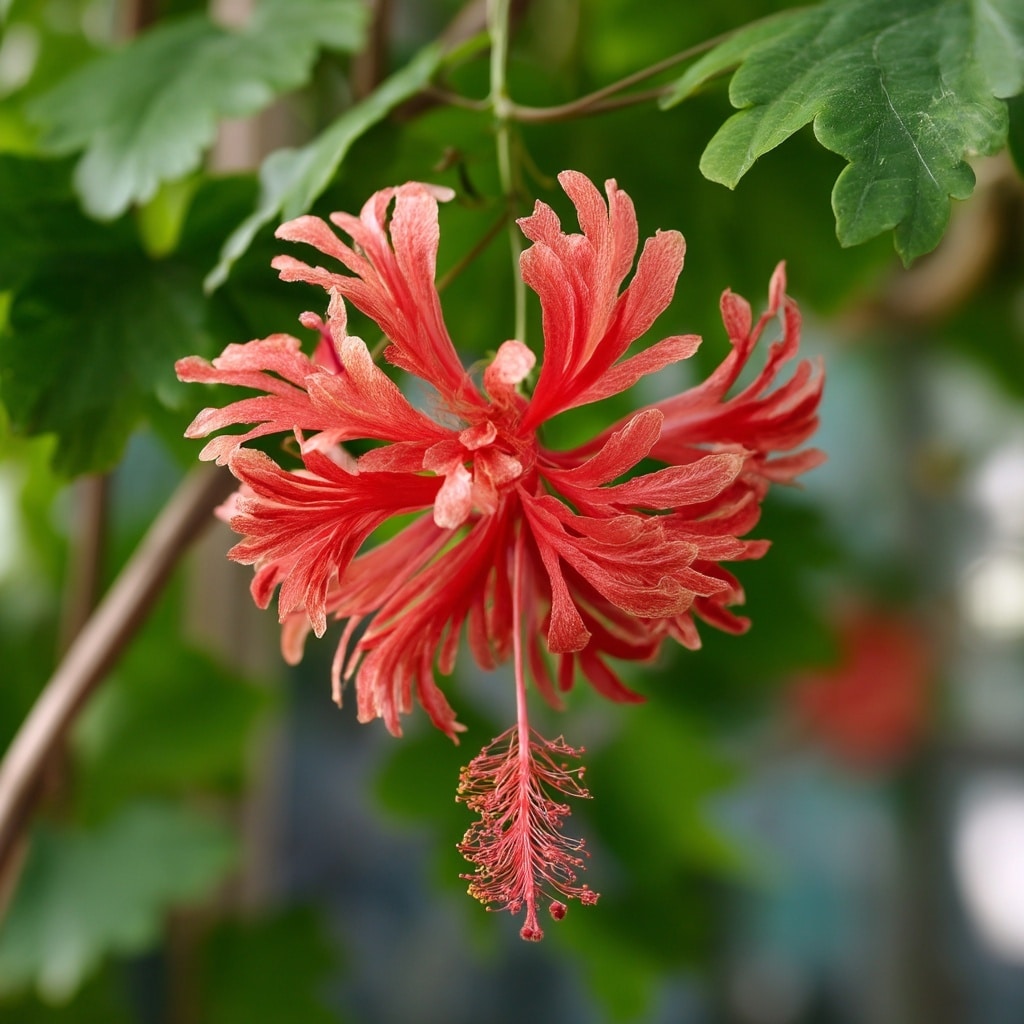
The Hibiscus schizopetalus, often called the Japanese Lantern or Fringed Hibiscus, is a tropical showpiece with one of the most exotic appearances in the hibiscus family. Native to East Africa, this variety is admired for its finely fringed petals and pendulous shape that resembles a lantern in bloom.
Key Features:
- Elegant, hanging flowers: Blooms dangle gracefully, measuring 5–7 cm across, with deeply cut, lacy petals.
- Vibrant color palette: Typically bright red or pink, often catching the light for a shimmering effect.
- Long, prominent staminal column: This adds further drama to the flower’s downward-facing structure.
- Vine-like growth habit: Though technically a shrub, it often grows like a climbing vine and benefits from staking or support.
This hibiscus flower is ideal for hanging baskets, trellises, or tropical-themed gardens where its unusual silhouette can be fully appreciated. It thrives in hot, humid environments and blooms prolifically when given enough sun.
7. Hibiscus trionum (Flower of an Hour)
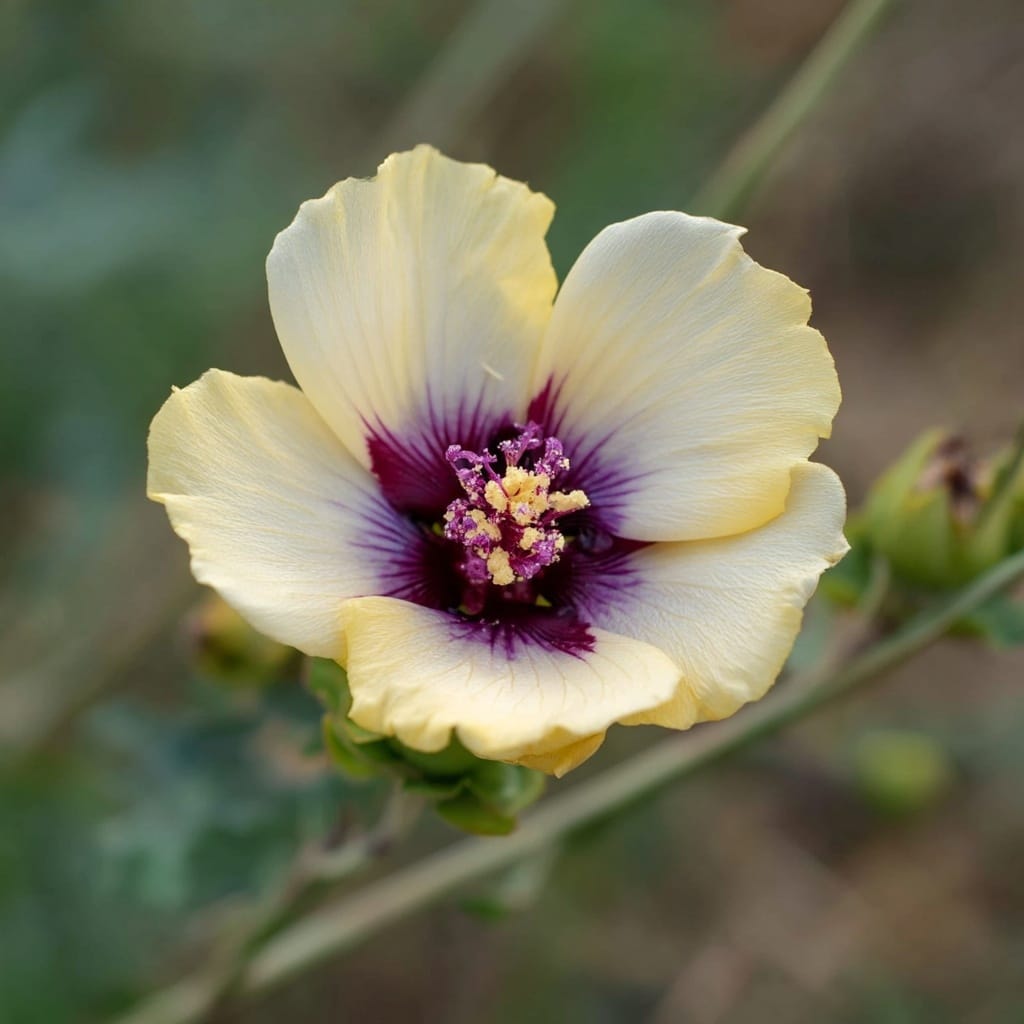
The Hibiscus trionum, known as the Flower of an Hour, is a delicate annual plant that lives up to its name. Each bloom opens for only a few short hours, usually in the late morning, before wilting by afternoon. Despite this brevity, the flower’s striking appearance makes it a charming addition to any garden.
Key Features:
- Short-lived beauty: Each flower lasts only a single day, typically just a few hours — but new blooms appear daily during the season.
- Unique color contrast: Pale yellow or creamy petals with a deep purple or black center create a dramatic look.
- Compact and easy to grow: The plant reaches about 30–100 cm in height, making it suitable for small gardens or pots.
- Naturalized in many regions: Native to Europe, Asia, and Africa, it often grows in wild fields, ditches, or garden edges.
While fleeting, this hibiscus flower adds whimsy and variety to borders and wildflower gardens. Its ephemeral blooms remind us to slow down and appreciate nature’s brief, beautiful moments.
Uses of Hibiscus Flowers
The hibiscus flower is admired worldwide for its beauty, but its value extends far beyond the garden. From the kitchen to the skincare aisle and even into cultural rituals, hibiscus flowers offer a wide range of practical and symbolic uses.
1. Floral Arrangements & Décor
- The bold, tropical appearance of hibiscus makes it a popular choice for fresh bouquets and exotic-themed decorations.
- Larger varieties like Hibiscus rosa-sinensis and Japanese Lantern are perfect for centerpieces or summer floral installations.
2. Meaningful Gifts
- Hibiscus flowers symbolize beauty, femininity, and delicate charm, making them ideal for occasions like:
- Birthdays
- Anniversaries
- Graduations
- Their vibrant colors and graceful petals make them stand out among traditional flowers.
3. Culinary Delights
- The Roselle variety is widely used in:
- Herbal teas (especially hibiscus tea, known for its tangy flavor and deep red color)
- Jams and jellies
- Syrups and sauces
- Hibiscus-infused recipes are popular in Caribbean, Middle Eastern, and African cuisines.
4. Skincare & Beauty
- Rich in antioxidants and natural acids, hibiscus extracts are often included in:
- Hydrating creams
- Anti-aging serums
- Hair treatments
- It’s sometimes called “nature’s Botox” for its firming and exfoliating effects on skin.
5. Cultural & Religious Ceremonies
- In many cultures, hibiscus flowers are offered in religious rituals or used to decorate altars.
- In Hawaiian and Polynesian traditions, wearing a hibiscus flower behind the ear holds social meaning (e.g., marital status).
Whether you’re sipping hibiscus tea or adding flair to a floral display, the hibiscus flower is more than just a pretty bloom—it’s a symbol of vitality, wellness, and cultural richness.
Fun Facts About Hibiscus Flowers
The hibiscus flower is more than just a pretty face. Behind its colorful petals lies a world of botanical quirks, cultural meanings, and natural surprises that make this plant truly unforgettable.
🌈 1. Some Hibiscus Flowers Change Color
- Hibiscus mutabilis (Confederate Rose) is known for its magical transformation—from white in the morning to deep pink or red by night.
- This change is due to pH shifts and pigment responses to sunlight exposure.
👩🎨 2. A Global Symbol of Femininity
- In many cultures, especially in the Pacific Islands and Southeast Asia, the hibiscus flower represents feminine beauty, grace, and delicate strength.
- In Malaysia, it’s the national flower—symbolizing unity and courage.
⏱ 3. Short-Lived, but Constant Bloomers
- Most hibiscus flowers last just 1–2 days, with Hibiscus trionum blooming for only a few hours.
- But don’t worry—they’re prolific bloomers, often producing fresh flowers daily throughout the growing season.
💪 4. Health Benefits in Every Sip
- Hibiscus tea, especially from Roselle, is rich in vitamin C, antioxidants, and anthocyanins.
- It’s known to help:
- Lower blood pressure
- Aid digestion
- Support liver health
🦋 5. Butterfly & Bee Magnet
- Many hibiscus varieties attract pollinators like bees, butterflies, and hummingbirds—making them a beneficial addition to any eco-conscious garden.
These fun facts show just how dynamic the hibiscus flower is—not only a visual delight, but also a plant full of surprises, symbolism, and wellness.
Conclusion About Different Types of Hibiscus Flowers
From towering tropical blooms to delicate, short-lived petals, the hibiscus flower comes in an incredible range of shapes, colors, and personalities. Whether you’re growing them for ornamental beauty, health benefits, or cultural meaning, each type of hibiscus brings its own unique charm to the garden.
With varieties like the bold Chinese Hibiscus, the color-changing Confederate Rose, and the functional Roselle, there’s a hibiscus flower for every climate, garden style, and personal preference.
No matter which one you choose, adding hibiscus to your outdoor space is sure to bring color, life, and a touch of tropical magic to your day.


